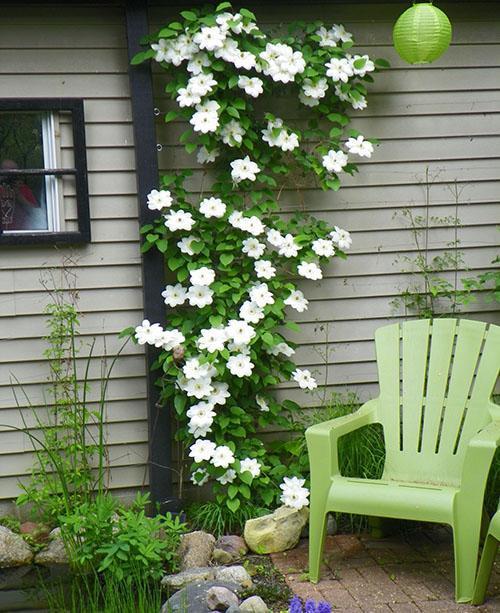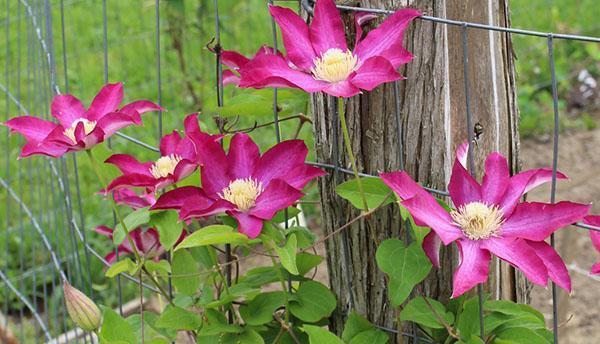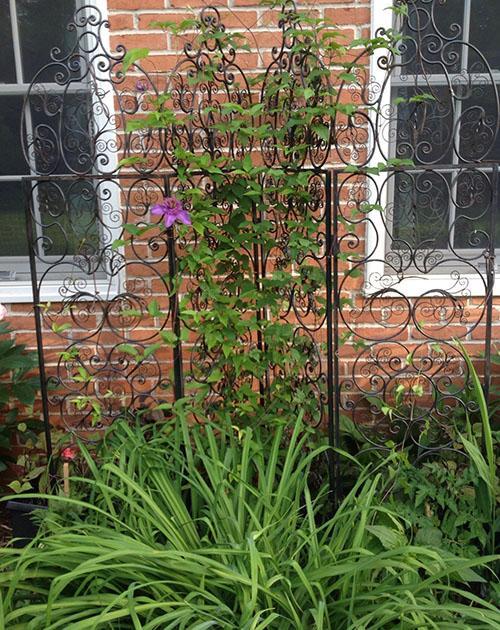Choosing the place and time of planting clematis at their summer cottage
 Clematis (photo) - the brightest, unforgettable vine on the Russian sites. If the summer resident only has to "tame" clematis, planting and caring for them in the open field is the key to success.
Clematis (photo) - the brightest, unforgettable vine on the Russian sites. If the summer resident only has to "tame" clematis, planting and caring for them in the open field is the key to success.
If everything is done correctly, the plants have been developing and blooming in one place for more than 20 years, annually decorating the house and the backyard with hundreds of simple and double flowers of different colors and shapes.
Choosing a place and preparing for planting clematis in open ground

Plants have an extremely negative attitude to the wind, the proximity of groundwater. Although plants need a lot of moisture for active growth, its stagnation threatens with root rot.
Novice growers are mistaken when clematis are planted in the ground near the wall of the house, where the vine regularly falls under the drain or, due to the lack of access to fresh air, is attacked by pests and pathogenic fungi.
It is best to find a place at a distance of at least 70 cm from the wall, and to build a strong lattice, arch or trellis for support. Such a distance from the capital structure will simplify the care of clematis after planting in the open field and protect it from streams of rain and melt water. Since the vines should grow strongly, without lack of nutrition and moisture, a gap of at least 1-1.5 meters is left between individual bushes.
 If multi-row planting is planned, the planting trenches are located from north to south. This will ensure that all plants are evenly and safely illuminated throughout the day.
If multi-row planting is planned, the planting trenches are located from north to south. This will ensure that all plants are evenly and safely illuminated throughout the day.
For a single bush, it is better to find a place with good morning light.
When is clematis planted in the ground?
 The time of transfer of clematis to open ground depends on the selected planting material. Saplings with an open or peat-packed root system cannot wait long. When to plant clematis in open ground in the spring?
The time of transfer of clematis to open ground depends on the selected planting material. Saplings with an open or peat-packed root system cannot wait long. When to plant clematis in open ground in the spring?
They are planted in the spring, in April or in the first decade of May, before the shoots grow. Delay or summer planting threatens that clematis will enter the soil weakened, its acclimatization will last longer, and sometimes the plant dies.
An early purchased clematis sapling is often grown at home, so by the usual planting time it already has young shoots. If you take it out into the garden in April, when the main planting of clematis in open ground in the Moscow region is underway, the greens will suffer from frost. Such plants are planted in the second half of May, by which time all natural threats have passed.
Saplings of clematis with a closed root system tolerate planting without problems during the entire warm period. Shading on hot days will make acclimatization easier and faster.
In autumn, clematis is planted in open ground from August to October. For the time remaining before the onset of cold weather, the plant takes root and adapts to life in the garden. The specific planting dates depend on the weather and climatic conditions of the region. Late leads to freezing of vines that did not have time to settle down. For the winter soil mulch, and the plants themselves are covered with foliage, spruce branches or dense non-woven material.
Planting clematis in the ground
 Choosing the right place for clematis, which grows for a long time without transplanting, is very important.Even more important is the competent organization of a pit for planting clematis in open ground in spring or autumn.
Choosing the right place for clematis, which grows for a long time without transplanting, is very important.Even more important is the competent organization of a pit for planting clematis in open ground in spring or autumn.
In areas with closely lying groundwater, the danger of flooding, or simply dense heavy soil at the bottom of a trench or pit 60 cm deep, a high drainage is made of expanded clay, crushed red brick, stone chips and sand. Additionally, drainage ditches are equipped, through which excess water can freely leave the flower garden.
Supports for clematis are prepared in advance. In order not to disturb the root system, arches, trellises, mesh or other types of supports are dug in at the same time as planting.
A planting pit for a single clematis is made 60 cm deep and wide. Group planting requires the preparation of a single trench at the rate of one running meter per bush.
A drainage pillow is made at the bottom, and the soil selected from the pit is loosened, cleaned of weeds and mixed in equal parts with humus, peat... It is useful to add fertile garden soil to sandy soil. On the contrary, loosening sand is mixed into clay, dense soil for clematis. As a fertilizer, 100 grams of complex mineral fertilizing are applied to each bucket of soil, as well as about a liter of purified wood ash. The increased acidity of the soil is neutralized with dolomite flour, slaked lime or other similar means.
 The planting hole is half-filled, in the form of an equilateral mound in the middle, with the prepared substrate. A seedling with pre-straightened rhizomes is placed on its top. The root collar, or tillering site, should be below the estimated ground level, and the depth depends on the size and age of the decorative vine.
The planting hole is half-filled, in the form of an equilateral mound in the middle, with the prepared substrate. A seedling with pre-straightened rhizomes is placed on its top. The root collar, or tillering site, should be below the estimated ground level, and the depth depends on the size and age of the decorative vine.
For seedlings 2-3 years old, it is 6-12 cm, that is, not only the base of the plant will have to be deepened, but also the first pair of leaves or buds. 3-4 year old clematis deepen another 5-10 cm more. Such a measure will help the plant survive winter frosts and summer heat, and also stimulates the formation of several strong shoots.
After planting, the soil near clematis is watered, compacted and mulched, and protection from the sun and wind is built over the young plant.
Outdoor clematis care
 The first year after planting is the time for acclimatization and active growth. Therefore, the soil under the clematis is loosened and weeded as necessary. Watering should be regular, but not excessive. Strong seedlings form buds already in the first summer, but experienced florists advise to cut off future flowers, which risk seriously weakening another small plant. If minerals with organic matter were introduced into the planting pit, the first feeding is carried out only a year later, in the spring.
The first year after planting is the time for acclimatization and active growth. Therefore, the soil under the clematis is loosened and weeded as necessary. Watering should be regular, but not excessive. Strong seedlings form buds already in the first summer, but experienced florists advise to cut off future flowers, which risk seriously weakening another small plant. If minerals with organic matter were introduced into the planting pit, the first feeding is carried out only a year later, in the spring.
The growing shoots are neatly attached to the installed support and monitor the state of the greenery. At the beginning of summer, there is a high risk of damage to young shoots by sucking insects. Closer to autumn, with an increase in humidity and the difference between day and night temperatures, the risk of fungal diseases increases. Therefore, the care of clematis in the open field must include preventive and urgent treatments with plant protection products.
 If the seedling has given only one strong shoot, it can be pushed to tillering by pinching the tender top. Subsequently, to activate growth, you can use deep watering and feeding nitrogen fertilizers... You can add them;
If the seedling has given only one strong shoot, it can be pushed to tillering by pinching the tender top. Subsequently, to activate growth, you can use deep watering and feeding nitrogen fertilizers... You can add them;
- as a solution on wet ground;
- dry with obligatory loosening and watering;
- as foliar dressing, spraying.
In acidic soil, the root system of clematis develops extremely slowly. Spring watering with lime milk at the rate of 200 grams of lime per bucket of water will help deacidify the soil under plantings.
3-4 years after planting clematis in open ground, the summer resident may face unforeseen difficulties in caring for it. Subject to agricultural technology, the flowers become smaller, and the liana grows noticeably more slowly than before.The most common problem is lack of moisture. The compacted soil does not allow water to reach the roots, and loosening at such a depth is impossible. In this case, an intra-soil irrigation system will help, which allows saturating the deep layers of the soil, and then preventing them from drying out. At a distance of 30–40 cm from the clematis, several plastic bottles are poured in with an open neck down. During watering, they are filled with water, which gradually flows to the very roots of the flowering liana.
 Perennial clematis also need regular pruning, which helps plants get rid of damaged, old, dried out shoots. And the summer resident, who has mastered the peculiarities of cutting different types of clematis, will receive the most lush and early flowering of his wards.
Perennial clematis also need regular pruning, which helps plants get rid of damaged, old, dried out shoots. And the summer resident, who has mastered the peculiarities of cutting different types of clematis, will receive the most lush and early flowering of his wards.